2018 NISSAN ALTIMA power steering fluid
[x] Cancel search: power steering fluidPage 420 of 467
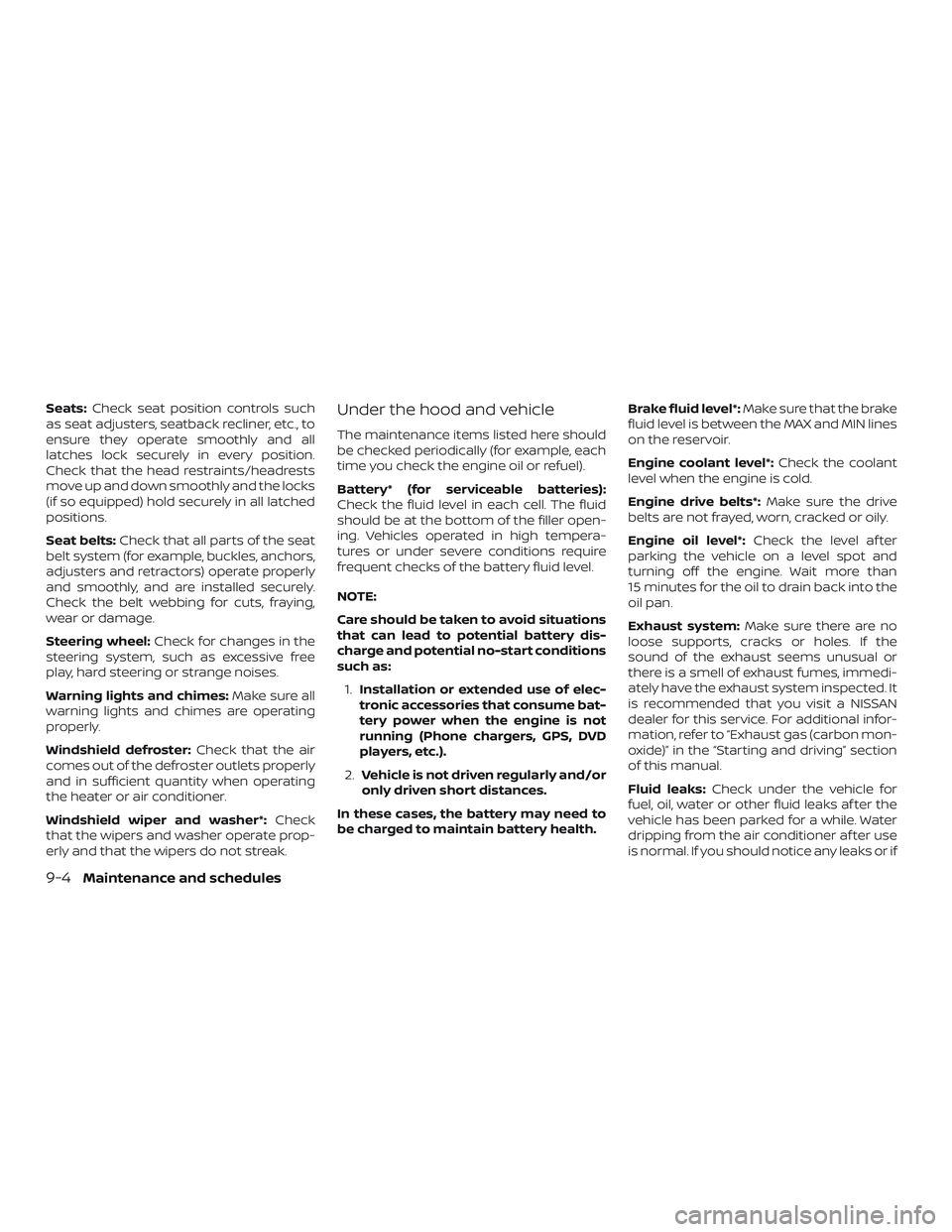
Seats:Check seat position controls such
as seat adjusters, seatback recliner, etc., to
ensure they operate smoothly and all
latches lock securely in every position.
Check that the head restraints/headrests
move up and down smoothly and the locks
(if so equipped) hold securely in all latched
positions.
Seat belts: Check that all parts of the seat
belt system (for example, buckles, anchors,
adjusters and retractors) operate properly
and smoothly, and are installed securely.
Check the belt webbing for cuts, fraying,
wear or damage.
Steering wheel: Check for changes in the
steering system, such as excessive free
play, hard steering or strange noises.
Warning lights and chimes: Make sure all
warning lights and chimes are operating
properly.
Windshield defroster: Check that the air
comes out of the defroster outlets properly
and in sufficient quantity when operating
the heater or air conditioner.
Windshield wiper and washer*: Check
that the wipers and washer operate prop-
erly and that the wipers do not streak.Under the hood and vehicle
The maintenance items listed here should
be checked periodically (for example, each
time you check the engine oil or refuel).
Battery* (for serviceable batteries):
Check the fluid level in each cell. The fluid
should be at the bottom of the filler open-
ing. Vehicles operated in high tempera-
tures or under severe conditions require
frequent checks of the battery fluid level.
NOTE:
Care should be taken to avoid situations
that can lead to potential battery dis-
charge and potential no-start conditions
such as:
1. Installation or extended use of elec-
tronic accessories that consume bat-
tery power when the engine is not
running (Phone chargers, GPS, DVD
players, etc.).
2. Vehicle is not driven regularly and/or
only driven short distances.
In these cases, the battery may need to
be charged to maintain battery health. Brake fluid level*:
Make sure that the brake
fluid level is between the MAX and MIN lines
on the reservoir.
Engine coolant level*: Check the coolant
level when the engine is cold.
Engine drive belts*: Make sure the drive
belts are not frayed, worn, cracked or oily.
Engine oil level*: Check the level af ter
parking the vehicle on a level spot and
turning off the engine. Wait more than
15 minutes for the oil to drain back into the
oil pan.
Exhaust system: Make sure there are no
loose supports, cracks or holes. If the
sound of the exhaust seems unusual or
there is a smell of exhaust fumes, immedi-
ately have the exhaust system inspected. It
is recommended that you visit a NISSAN
dealer for this service. For additional infor-
mation, refer to “Exhaust gas (carbon mon-
oxide)” in the “Starting and driving” section
of this manual.
Fluid leaks: Check under the vehicle for
fuel, oil, water or other fluid leaks af ter the
vehicle has been parked for a while. Water
dripping from the air conditioner af ter use
is normal. If you should notice any leaks or if
9-4Maintenance and schedules
Page 421 of 467
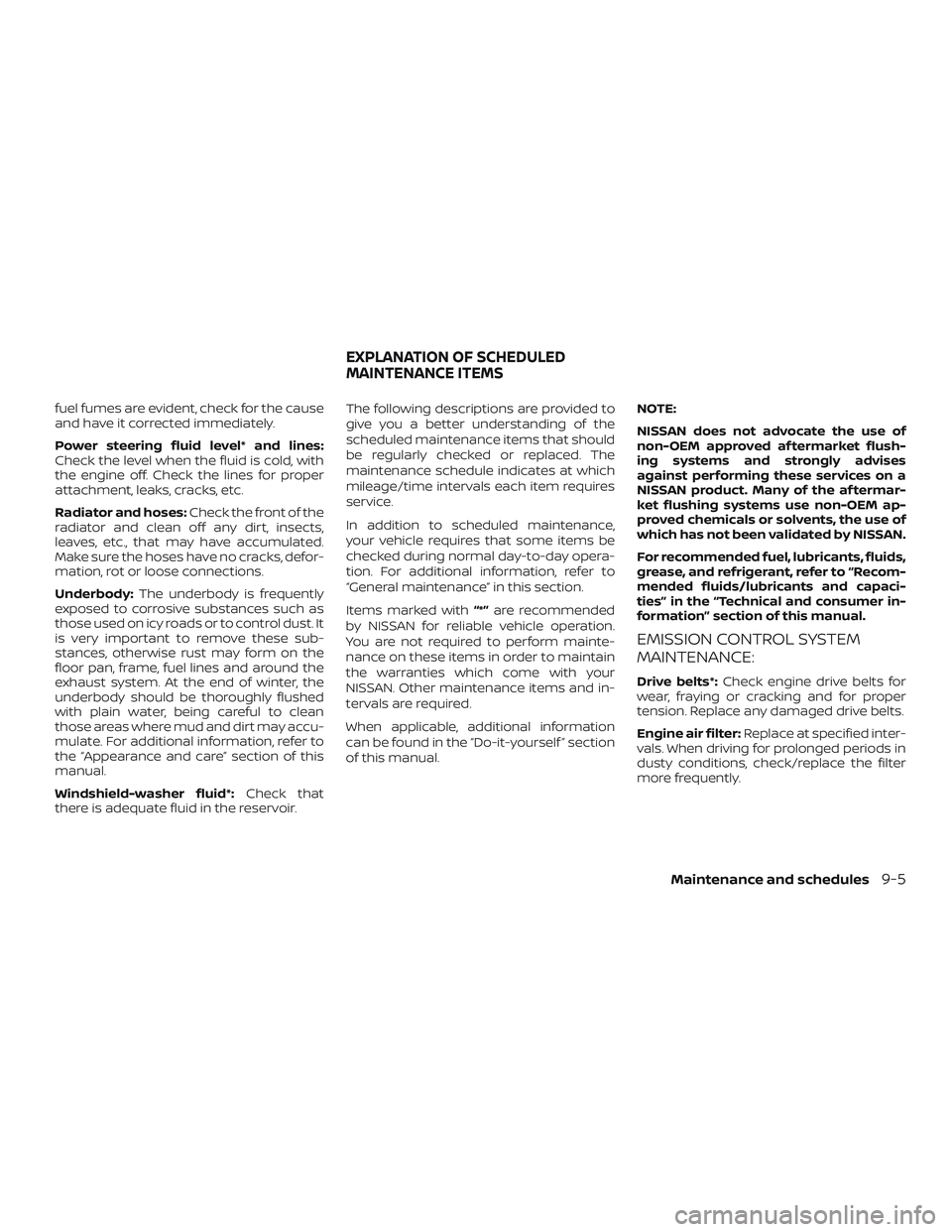
fuel fumes are evident, check for the cause
and have it corrected immediately.
Power steering fluid level* and lines:
Check the level when the fluid is cold, with
the engine off. Check the lines for proper
attachment, leaks, cracks, etc.
Radiator and hoses:Check the front of the
radiator and clean off any dirt, insects,
leaves, etc., that may have accumulated.
Make sure the hoses have no cracks, defor-
mation, rot or loose connections.
Underbody: The underbody is frequently
exposed to corrosive substances such as
those used on icy roads or to control dust. It
is very important to remove these sub-
stances, otherwise rust may form on the
floor pan, frame, fuel lines and around the
exhaust system. At the end of winter, the
underbody should be thoroughly flushed
with plain water, being careful to clean
those areas where mud and dirt may accu-
mulate. For additional information, refer to
the “Appearance and care” section of this
manual.
Windshield-washer fluid*: Check that
there is adequate fluid in the reservoir. The following descriptions are provided to
give you a better understanding of the
scheduled maintenance items that should
be regularly checked or replaced. The
maintenance schedule indicates at which
mileage/time intervals each item requires
service.
In addition to scheduled maintenance,
your vehicle requires that some items be
checked during normal day-to-day opera-
tion. For additional information, refer to
“General maintenance” in this section.
Items marked with
“*”are recommended
by NISSAN for reliable vehicle operation.
You are not required to perform mainte-
nance on these items in order to maintain
the warranties which come with your
NISSAN. Other maintenance items and in-
tervals are required.
When applicable, additional information
can be found in the “Do-it-yourself ” section
of this manual. NOTE:
NISSAN does not advocate the use of
non-OEM approved af termarket flush-
ing systems and strongly advises
against performing these services on a
NISSAN product. Many of the af termar-
ket flushing systems use non-OEM ap-
proved chemicals or solvents, the use of
which has not been validated by NISSAN.
For recommended fuel, lubricants, fluids,
grease, and refrigerant, refer to “Recom-
mended fluids/lubricants and capaci-
ties” in the “Technical and consumer in-
formation” section of this manual.
EMISSION CONTROL SYSTEM
MAINTENANCE:
Drive belts*:
Check engine drive belts for
wear, fraying or cracking and for proper
tension. Replace any damaged drive belts.
Engine air filter: Replace at specified inter-
vals. When driving for prolonged periods in
dusty conditions, check/replace the filter
more frequently.
EXPLANATION OF SCHEDULED
MAINTENANCE ITEMS
Maintenance and schedules9-5
Page 434 of 467
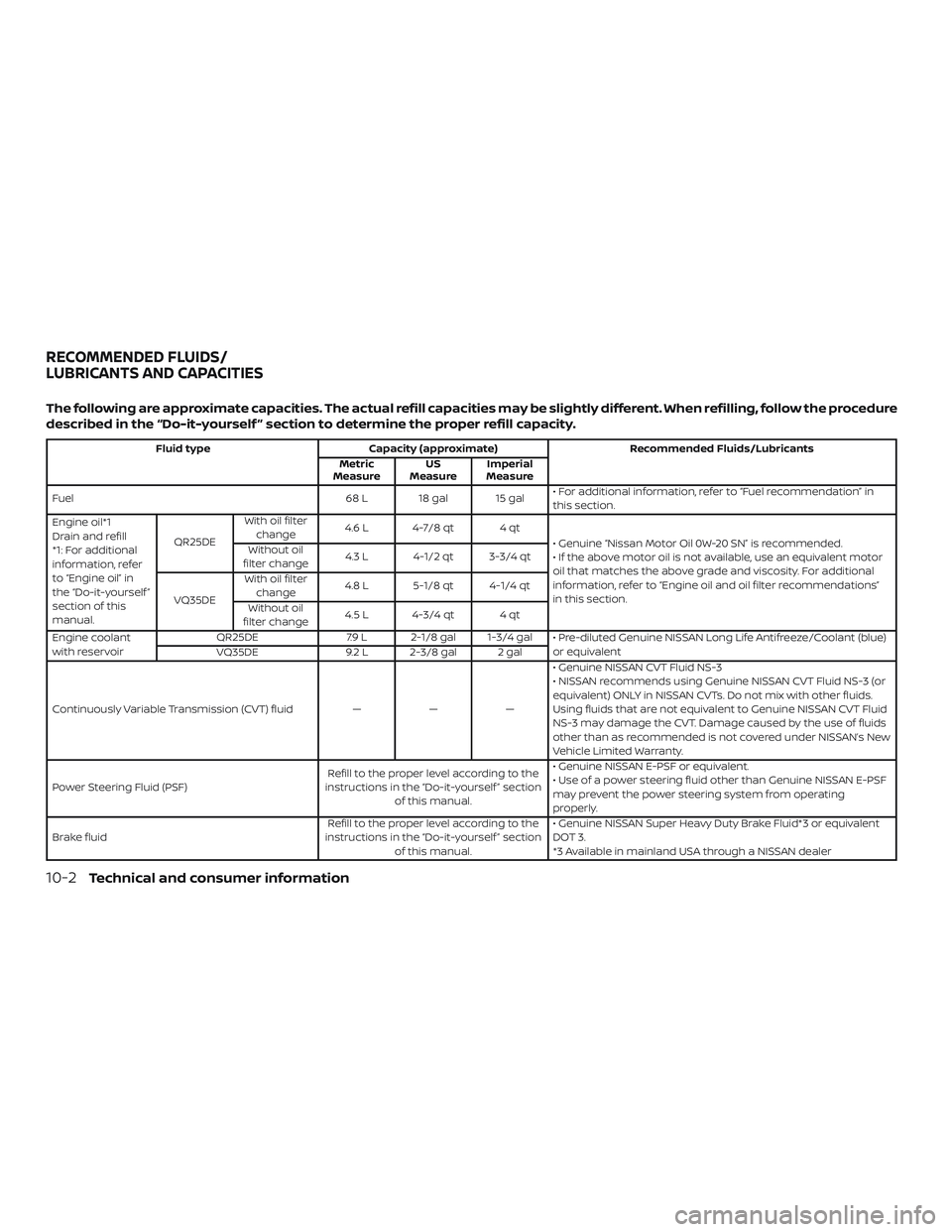
The following are approximate capacities. The actual refill capacities may be slightly different. When refilling, follow the procedure
described in the “Do-it-yourself ” section to determine the proper refill capacity.
Fluid typeCapacity (approximate) Recommended Fluids/Lubricants
Metric
Measure US
Measure Imperial
Measure
Fuel 68 L 18 gal 15 gal• For additional information, refer to “Fuel recommendation” in
this section.
Engine oil*1
Drain and refill
*1: For additional
information, refer
to “Engine oil” in
the “Do-it-yourself ”
section of this
manual. QR25DE
With oil filter
change 4.6 L 4-7/8 qt 4 qt
• Genuine “Nissan Motor Oil 0W-20 SN” is recommended.
• If the above motor oil is not available, use an equivalent motor
oil that matches the above grade and viscosity. For additional
information, refer to “Engine oil and oil filter recommendations”
in this section.
Without oil
filter change 4.3 L 4-1/2 qt 3-3/4 qt
VQ35DE With oil filter
change 4.8 L 5-1/8 qt 4-1/4 qt
Without oil
filter change 4.5 L 4-3/4 qt 4 qt
Engine coolant
with reservoir QR25DE
7.9 L 2-1/8 gal 1-3/4 gal
• Pre-diluted Genuine NISSAN Long Life Antifreeze/Coolant (blue)
or equivalent
VQ35DE 9.2 L 2-3/8 gal 2 gal
Continuously Variable Transmission (CVT) fluid ———• Genuine NISSAN CVT Fluid NS-3
• NISSAN recommends using Genuine NISSAN CVT Fluid NS-3 (or
equivalent) ONLY in NISSAN CVTs. Do not mix with other fluids.
Using fluids that are not equivalent to Genuine NISSAN CVT Fluid
NS-3 may damage the CVT. Damage caused by the use of fluids
other than as recommended is not covered under NISSAN’s New
Vehicle Limited Warranty.
Power Steering Fluid (PSF) Refill to the proper level according to the
instructions in the “Do-it-yourself ” section of this manual. • Genuine NISSAN E-PSF or equivalent.
• Use of a power steering fluid other than Genuine NISSAN E-PSF
may prevent the power steering system from operating
properly.
Brake fluid Refill to the proper level according to the
instructions in the “Do-it-yourself ” section of this manual. • Genuine NISSAN Super Heavy Duty Brake Fluid*3 or equivalent
DOT 3.
*3 Available in mainland USA through a NISSAN dealer
RECOMMENDED FLUIDS/
LUBRICANTS AND CAPACITIES
10-2Technical and consumer information
Page 457 of 467
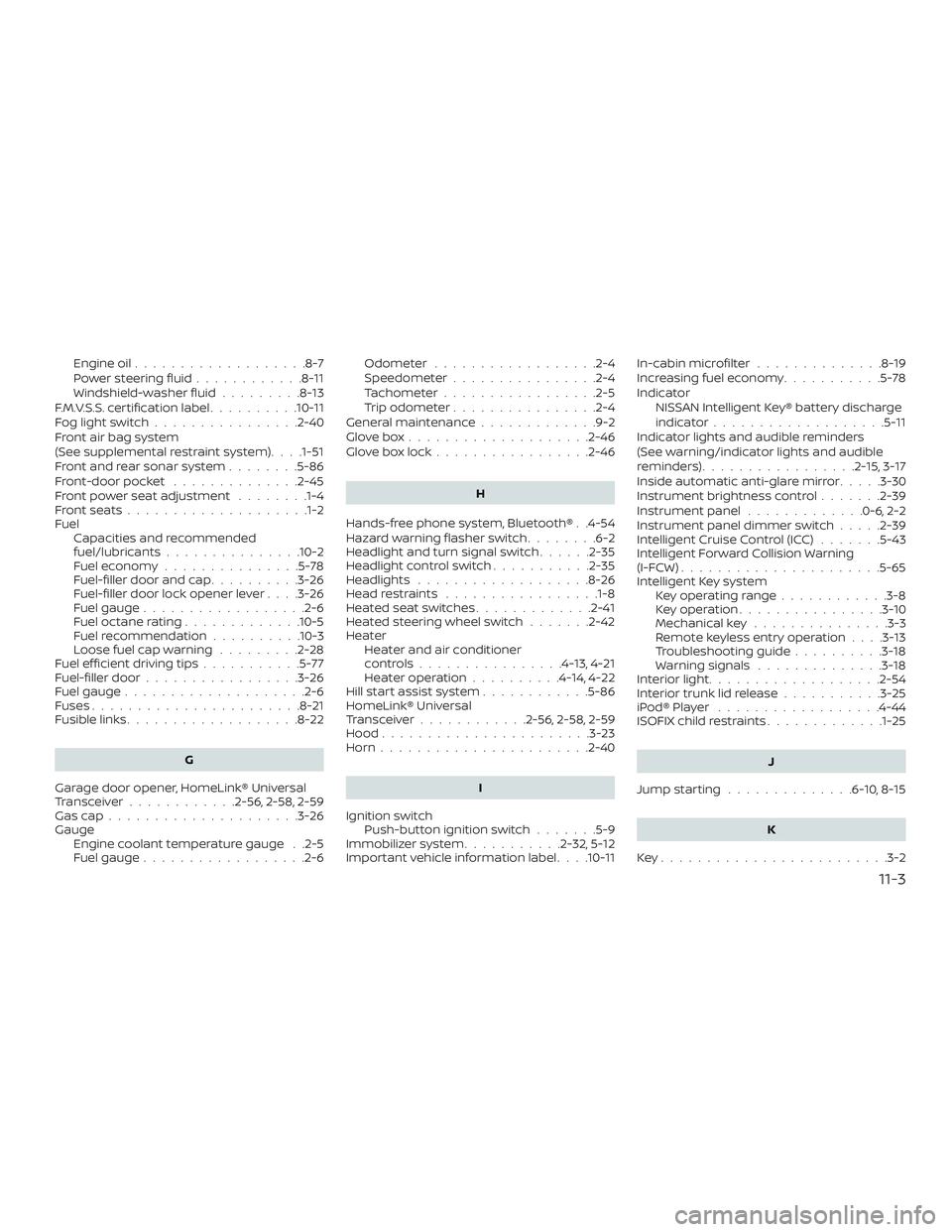
Engine oil...................8-7
Powersteeringfluid............8-11
Windshield-washer fluid .........8-13
F.M.V.S.S. certification label ..........10-11
Foglightswitch................2-40
Front air bag system
(See supplemental restraint system) . . . .1-51
Front and rear sonar system ........5-86
Front-door pocket ..............2-45
Front power seat adjustment ........1-4
Frontseats................... .1-2
Fuel Capacities and recommended
fuel/lubricants...............10-2
Fuel economy ...............5-78
Fuel-filler door and cap ..........3-26
Fuel-filler door lock opener lever ....3-26
Fuel gauge ..................2-6
Fueloctanerating.............10-5
Fuel recommendation ..........10-3
Loose fuel cap warning .........2-28
Fuelefficientdrivingtips...........5-77
Fuel-filler door .................3-26
Fuel gauge ....................2-6
Fuses .......................8-21
Fusiblelinks...................8-22
G
Garage door opener, HomeLink® Universal
Transceiver ............2-56,2-58,2-59
Gascap.....................3-26
Gauge Engine coolant temperature gauge . .2-5
Fuel gauge ..................2-6 Odometer
..................2-4
Speedometer ................2-4
Tachometer .................2-5
Trip odometer ................2-4
General maintenance .............9-2
Glovebox....................2-46
Gloveboxlock.................2-46
H
Hands-free phone system, Bluetooth® . .4-54
Hazard warning flasher switch ........6-2
Headlight and turn signal switch ......2-35
Headlightcontrolswitch...........2-35
Headlights ...................8-26
Headrestraints .................1-8
Heated seat switches .............2-41
Heated steering wheel switch .......2-42
Heater Heater and air conditioner
controls................4-13,4-21
Heater operation ..........4-14,4-22
Hill start assist system ............5-86
HomeLink® Universal
Transceiver ............2-56,2-58,2-59
Hood .......................3-23
Horn.......................2-40
I
Ignition switch Push-button ignition switch .......5-9
Immobilizer system ...........2-32,5-12
Important vehicle information label . . . .10-11In-cabinmicrofilter ..............8-19
Increasing fuel economy
...........5-78
Indicator NISSAN Intelligent Key® battery discharge
indicator...................5-11
Indicator lights and audible reminders
(See warning/indicator lights and audible
reminders) .................2-15,3-17
Inside automatic anti-glare mirror .....3-30
Instrument brightness control .......2-39
Instrument panel .............0-6,2-2
Instrument panel dimmer switch .....2-39
Intelligent
Cruise Control (ICC) .......5-43
Intelligent Forward Collision Warning
(I-FCW)......................5-65
Intelligent Key system Key operating range ............3-8
Key operation ................3-10
Mechanical key ...............3-3
Remote keyless entry operation ....3-13
Troubleshooting guide ..........3-18
Warning signals ..............3-18
Interiorlight...................2-54
Interiortrunklidrelease...........3-25
iPod®Player ..................4-44
ISOFIX child restraints .............1-25
J
Jumpstarting..............6-10,8-15
K
Key........................ .3-2
11-3
Page 459 of 467
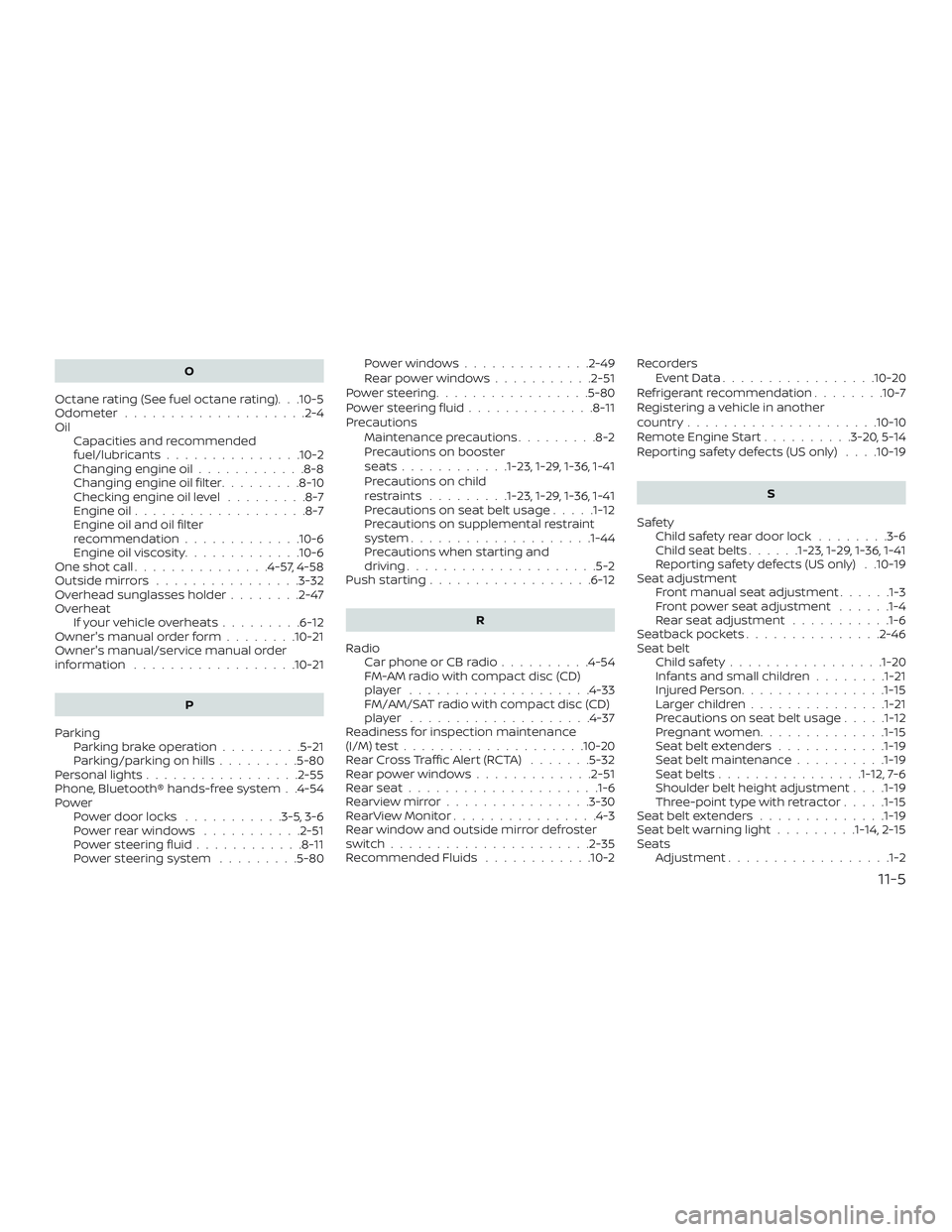
O
Octane rating (See fuel octane rating). . .10-5
Odometer ....................2-4
Oil Capacities and recommended
fuel/lubricants...............10-2
Changing engine oil ............8-8
Changing engine oil filter .........8-10
Checking engine oil level .........8-7
Engine oil ...................8-7
Engine oil and oil filter
recommendation .............10-6
Engine oil viscosity .............10-6
One shot call ...............4-57,4-58
Outsidemirrors................3-32
Overhead sunglasses holder ........2-47
Overheat Ifyourvehicleoverheats.........6-12
Owner's manual order form ........10-21
Owner's manual/service manual order
information ..................10-21
P
Parking Parking brake operation .........5-21
Parking/parkingonhills.........5-80
Personal lights .................2-55
Phone, Bluetooth® hands-free system . .4-54
Power Power door locks ...........3-5,3-6
Powerrearwindows ...........2-51
Powersteeringfluid............8-11
Power steering system .........5-80Powerwindows..............2-49
Rearpowerwindows...........2-51
Powersteering.................5-80
Powersteeringfluid..............8-11
Precautions Maintenance precautions .........8-2
Precautions on booster
seats............1-23, 1-29, 1-36, 1-41
Precautions on child
restraints .........1-23, 1-29, 1-36, 1-41
Precautions on seat belt usage .....1-12
Precautions on supplemental restraint
system ................... .1-44
Precautions when starting and
driving.....................5-2
Push starting ..................6-12
R
Radio Car phone or CB radio ..........4-54
FM-AM radio with compact disc (CD)
player ....................4-33
FM/AM/SAT radio with compact disc (CD)
player ....................4-37
Readiness for inspection maintenance
(I/M) test ....................10-20
RearCrossTrafficAlert(RCTA) .......5-32
Rearpowerwindows.............2-51
Rearseat.................... .1-6
Rearviewmirror................3-30
RearViewMonitor................4-3
Rear window and outside mirror defroster
switch......................2-35
Recommended Fluids ............10-2 Recorders
EventData................ .10-20
Refrigerant recommendation ........10-7
Registering a vehicle in another
country .....................10-10
Remote Engine Start ..........3-20,5-14
Reporting safety defects (US only) . . . .10-19
S
Safety Child safety rear door lock ........3-6
Childseatbelts......1-23, 1-29, 1-36, 1-41
Reporting safety defects (US only) . .10-19
Seat adjustment Front manual seat adjustment ......1-3
Front power seat adjustment ......1-4
Rear seat adjustment ...........1-6
Seatback pockets ...............2-46
Seat belt Childsafety................ .1-20
Infants
and small children ........1-21
InjuredPerson............... .1-15
Largerchildren.............. .1-21
Precautionsonseatbeltusage.....1-12
Pregnant women ..............1-15
Seat belt extenders ............1-19
Seat belt maintenance ..........1-19
Seatbelts................1-12, 7-6
Shoulder belt height adjustment . . . .1-19
Three-pointtypewithretractor.....1-15
Seat belt extenders ..............1-19
Seatbeltwarninglight.........1-14, 2-15
Seats Adjustment ..................1-2
11-5
Page 460 of 467
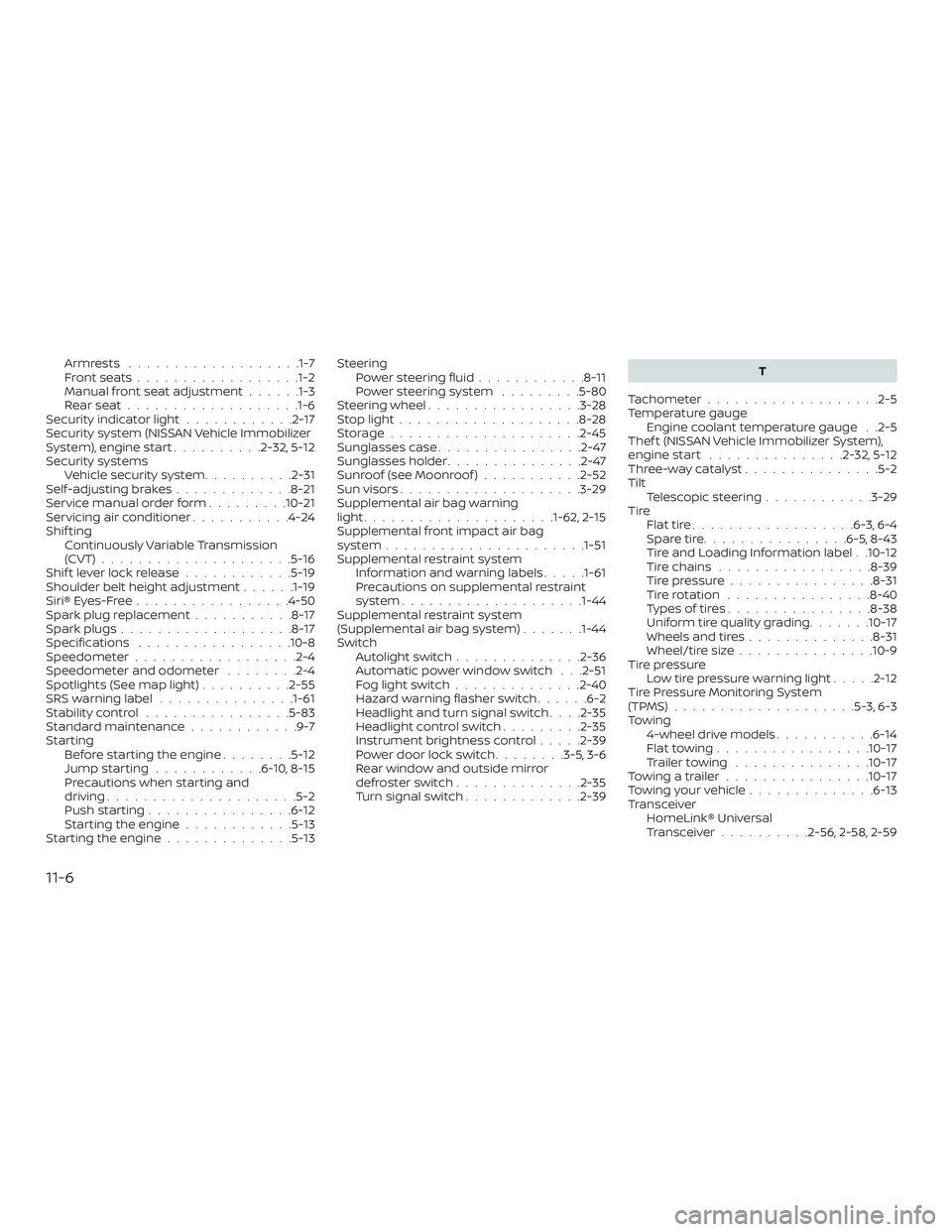
Armrests ...................1-7
Frontseats..................1-2
Manual front seat adjustment ......1-3
Rearseat.................. .1-6
Security indicator light ............2-17
Security system (NISSAN Vehicle Immobilizer
System), engine start ..........2-32,5-12
Security systems Vehicle security system ..........2-31
Self-adjustingbrakes.............8-21
Service manual order form .........10-21
Servicing air conditioner ...........4-24
Shif ting Continuously Variable Transmission
(CVT) .....................5-16
Shiftleverlockrelease............5-19
Shoulder belt height adjustment ......1-19
Siri® Eyes-Free .................4-50
Spark plug replacement ...........8-17
Spark plugs ...................8-17
Specifications .................10-8
Speedometer ..................2-4
Speedometer and odometer ........2-4
Spotlights(Seemaplight)..........2-55
SRS warning label ...............1-61
Stability control ................5-83
Standard maintenance ............9-7
Starting Before starting the engine ........5-12
Jumpstarting............6-10,8-15
Precautions when starting and
driving .....................5-2
Push starting ................6-12
Starting the engine ............5-13
Starting the engine ..............5-13 Steering
Powersteeringfluid............8-11
Powersteeringsystem .........5-80
Steering wheel .................3-28
Stoplight....................8-28
Storage.....................2-45
Sunglasses case ................2-47
Sunglasses holder ...............2-47
Sunroof (see Moonroof ) ...........2-52
Sunvisors....................3-29
Supplemental air bag warning
light.................... .1-62, 2-15
Supplemental front impact air bag
system ..................... .1-51
Supplemental restraint system Information and warning labels .....1-61
Precautions on supplemental restraint
system ................... .1-44
Supplemental restraint system
(Supplemental air bag system) .......1-44
Switch Autolightswitch..............2-36
Automatic power window switch . . .2-51
Foglightswitch..............2-40
Hazard warning flasher switch ......6-2
Headlight and turn signal switch ....2-35
Headlightcontrolswitch.........2-35
Instrument brightness control .....2-39
Power door lock switch ........3-5,3-6
Rear window and outside mirror
defrosterswitch..............2-35
Turn signal switch .............2-39 T
Tachometer ...................2-5
Temperature gauge Engine coolant temperature gauge . .2-5
Thef t (NISSAN Vehicle Immobilizer System),
engine start ...............2-32,5-12
Three-waycatalyst...............5-2
Tilt Telescopicsteering............3-29
Tire F
lattire..................6-3,6-4
Spare tire ................6-5,8-43
Tire and Loading Information label . .10-12
Tire chains .................8-39
Tire pressure ................8-31
Tirerotation ................8-40
Types of tires ................8-38
Uniform tire quality grading .......10-17
Wheels and tires ..............8-31
Wheel/tire size ...............10-9
Tire pressure Low tire pressure warning light .....2-12
Tire Pressure Monitoring System
(TPMS)....................5-3,6-3
Towing 4-wheel drive models ...........6-14
Flattowing.................10-17
Trailertowing ...............10-17
Towingatrailer................10-17
Towingyourvehicle..............6-13
Transceiver HomeLink® Universal
Transceiver ..........2-56,2-58,2-59
11-6